I know that it might not look like it from this question, but I've actually been programming for over 20 years, but I'm new to R. I'm trying to move away from Excel and to automate creation of about 100 charts I currently do in Excel by hand. I've asked two previous questions about this: here and here. Those solutions work for those toy examples, but when I try the exact same code on my own full program, they behave very differently and I'm completely befuddled as to why. When I run the program below, the testplot.png file is just a plot of the line, without the stacked bar chart.
So here is my (full) code as cut down as I can make it. If anyone wants to critique my programming, go ahead. I know that the comments are light, but that's to try to shorten it for this post. Also, this does actually download the USDA PSD database which is about 20MB compressed and is 170MB uncompressed...sorry but I would love someone's help on this!
Edit, here are str() outputs of both 'full' data and 'toy' data. The toy data works, the full data doesn't.
> str(melteddata)
Classes ‘data.table’ and 'data.frame': 18 obs. of 3 variables:
$ Year : int 1 2 3 4 5 6 1 2 3 4 ...
$ variable: Factor w/ 3 levels "stocks","exports",..: 1 1 1 1 1 1 2 2 2 2 ...
$ Qty : num 2 4 3 2 4 3 4 8 6 4 ...
- attr(*, ".internal.selfref")=<externalptr>
> str(SoySUHist)
Classes ‘data.table’ and 'data.frame': 159 obs. of 3 variables:
$ Year : int 1964 1965 1966 1967 1968 1969 1970 1971 1972 1973 ...
$ variable: Factor w/ 3 levels "Stocks","DomCons",..: 1 1 1 1 1 1 1 1 1 1 ...
$ Qty : num 0.0297 0.0356 0.0901 0.1663 0.3268 ...
- attr(*, ".internal.selfref")=<externalptr>
> str(linedata)
Classes ‘data.table’ and 'data.frame': 6 obs. of 2 variables:
$ Year: int 1 2 3 4 5 6
$ Qty : num 15 16 15 16 15 16
- attr(*, ".internal.selfref")=<externalptr>
> str(SoyProd)
Classes ‘data.table’ and 'data.frame': 53 obs. of 2 variables:
$ Year: int 1964 1965 1966 1967 1968 1969 1970 1971 1972 1973 ...
$ Qty : num 701 846 928 976 1107 ...
- attr(*, ".internal.selfref")=<externalptr>
>
library(data.table)
library(ggplot2)
library(ggthemes)
library(plyr)
toyplot <- function(plotdata,linedata){
plotCExp <- ggplot(plotdata) +
geom_bar(aes(x=Year,y=Qty,factor=variable,fill=variable), stat="identity") +
geom_line(data=linedata, aes(x=Year,y=Qty)) # <---- comment out this line & the stack plot works
ggsave(plotCExp,filename = "ggsavetest.png", width=7, height=5, units="in")
}
convertto <- function(value,crop,unit='BU'){
if (unit=='BU' & ( crop=='WHEAT' | crop=='SOYBEANS')){
value = value * 36.7437
}
return(value)
}
# =====================================
# Download Data (Warning...large download!)
# =====================================
system("curl https://apps.fas.usda.gov/psdonline/download/psd_alldata_csv.zip | funzip > DATA/psd.csv")
tmp <- fread("DATA/psd.csv")
PSD = data.table(tmp)
rm(tmp)
setkey(PSD,Country_Code,Commodity_Code,Attribute_ID)
tmp=unique(PSD[,.(Commodity_Description,Attribute_Description,Commodity_Code,Attribute_ID)])
tmp[order(Commodity_Description)]
names(PSD)[names(PSD) == "Market_Year"] = "Year"
names(PSD)[names(PSD) == "Value"] = "Qty"
PSDCmdtyAtt = unique(PSD[,.(Commodity_Code,Attribute_ID)])
# Soybean Production, Consumpion, Stocks/Use
SoyStocks = PSD[list("US",2222000,176),.(Year,Qty)] # Ending Stocks
SoyExp = PSD[list("US",2222000,88),.(Year,Qty)] # Exports
SoyProd = PSD[list("US",2222000,28),.(Year,Qty)] # Total Production
SoyDmCons = PSD[list("US",2222000,125),.(Year,Qty)] # Total Dom Consumption
SoyStocks$Qty = convertto(SoyStocks$Qty,"SOYBEANS","BU")/1000
SoyExp$Qty = convertto(SoyExp$Qty,"SOYBEANS","BU")/1000
SoyProd$Qty = convertto(SoyProd$Qty,"SOYBEANS","BU")/1000
SoyDmCons$Qty = convertto(SoyDmCons$Qty,"SOYBEANS","BU")/1000
# Stocks/Use
SoySUPlot <- SoyExp
names(SoySUPlot)[names(SoySUPlot) == "Qty"] = "Exports"
SoySUPlot$DomCons = SoyDmCons$Qty
SoySUPlot$Stocks = SoyStocks$Qty
SoySUHist <- melt(SoySUPlot,id.vars="Year")
SoySUHist$Qty = SoySUHist$value/1000
SoySUHist$value <- NULL
SoySUPlot$StocksUse = 100*SoySUPlot$Stocks/(SoySUPlot$DomCons+SoySUPlot$Exports)
SoySUPlot$Production = SoyProd$Qty/1000
SoySUHist$variable <- factor(SoySUHist$variable, levels = rev(levels(SoySUHist$variable)))
SoySUHist = arrange(SoySUHist,variable)
toyplot(SoySUHist,SoyProd)


